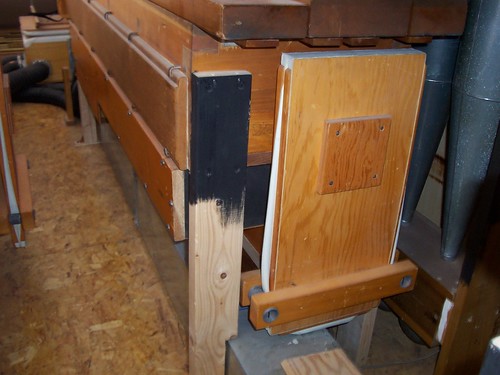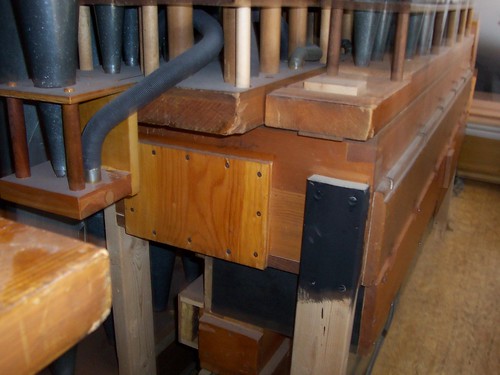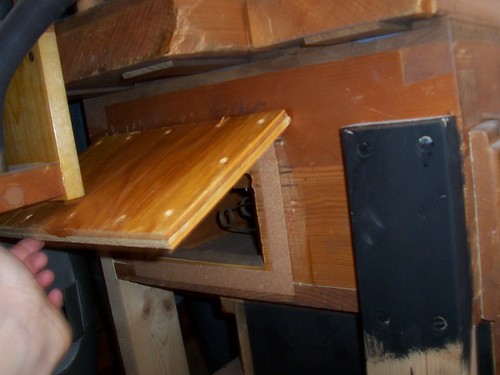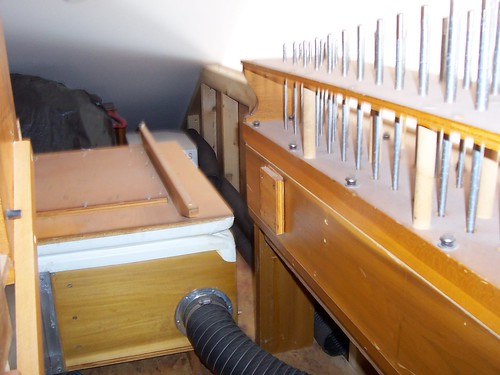Winkers for the Great

The wind system is a bit unsteady on the great division. It was on the swell too, but we added these winker bellows to steady the pressure soon after we first installed the organ. The close one is on the swell main chest and the one on the left side of the picture is for the facade swell spitzprincipal unit chest. (None of the swell division is actually enclosed. There was no room in our space. I'm hoping to rearrange things eventually to allow for it).
Below is the bass end of the great main chest. I'd like to add a winker there:

Check out the nice joinery on these 100-or-so-year-old slider chests. They don't make em like this anymore! They've sure been adulterated since as you can see, with 2X4's, sheetrock screws, subfloor-grade plywood blankoffs, and very slow-repeating EP action (replacing what I assume to be tracker). But they work! The chests are marked "Opus 406" but I do not know the maker. The seller said it was Hook and Hastings but I have confirmed that to be impossible. Opus 406 was back in the 1880's or so, when the company was E&GG Hook, and is still extant.
I was hoping under this blankoff plate I'd find mounting holes for a winker, but nope, looks like there used to be a windline here:

But no big deal, I'll make a new plate out of some plywood that is not quite so subfloor-grade and mount the winker to it. I also want to mount a winker on the great octave unit chest, below. That square plate with the 4 screws covers where one used to be, so that should be easy, though I think I'll have to mount it sideways in order to clear the wind regulator:

10 Comments:
Is the winker shown in the top photo (in the steady wind section) just a
shock absorber that the wind pushes open against a spring? Can it be shut
off so a tremolo can function? I enjoy the photos and an insight into your
project.
Thanks!
Yep, there're two winkers in that photo, and both are exactly that... shock absorbers. At this time there is no tremolo installed, but there is a stoptab for one. The organ had a tremolo in its previous installation (affecting just the swell I think) but we didn't install it here. I don't remember why. I think we threw it away because it was a poor design or something. There is no way to isolate the winkers but if we install a tremolo, which I intend to at some point, we'll need to provide one. I'll be looking for advice as to different options for tremolos and for shutting off winkers.
(the second winker is barely visible at the extreme left of the photo, mounted on an the swell spritzprincipal unit chest for pipes 25-97 of that rank)
My rules of thumb for happy winding systems:
1 - Lose the flexhaust
2 - Use more regulator springs, less weights (Weights have inertia,
which can be quite bad. A small one is good for the tremolo though)
3 - Make the static pressure at the cone box/curtain valve within 1"-2"
of the regulated pressure
4 - Low pressure = Large ducts to overcome friction, High pressure=
Small ducts
5 - Winker or Schwimmer tremolos are evil, Skinner style is ideal,
inertial o.k. if adjustable enough
6 - Keep the chest regulator under the chest nice and close
7 - Avoid long, narrow runs of any ducts except for the pneumatic
tremolo
8 - Twists, turns, significant pressure reductions, crushed ducts, and square ducts = turbulence
9 - Make sure the regulator head comes up squarely; especially with cone-valves
You could just mount some kind of mechanical or electrical assembly
that oscillates the Winker and voila, you have your Tremulant.
Tremulant drivers using pulsations can be set-up to drive slider
motors or magnetic coupler motors and do the job very effectively.
Good stuff! Thanks. All in the works. Except I didn't know square windlines cause turbulence. You mean square cross section? A lot of our voicing sounds very "nervous" and I think a lot of it is turbulence. We have no static regulator, and was going to ask if that could be a major contributor. The wind goes straight from blower to final regulator. I think installing a static regulator is in my near future. I do hope to get rid of flexhaust over time, once I figure out just where each chest will live permanently.
Wow. You're not the only one with the disease, Andy, and many have it worse than you.
It can get REAL ugly. It tends to hit those with barns or large garages the worst.
Dear Andy:
A static regulator may help your situation, but there was
a device someone came up with to dampen turbulence
altogether. He used 1 foot long pieces of PVC 1/2 to 3/4"
diameter glued together filling the wind line which broke
large vortices into very small non invasive ones, He claimed
it was as calm as hand pumped wind eliminating the pipe twitter.
Just a thought.
If you can eliminate the use of flexhaust entirely use 4" or 6"
PVC it's smooth walled. I believe it was an Austin a guy added
a Vox Humana and used 45' of flexhaust for the tremolo, it worked.
A regular tremolo won't work on an Austin because of the way they are
built. They use a fan tremolo instead over the pipes.
Ron
VERY INTERESTING on the PVC pipe turbulence damper. That wouldn't be all that hard to make.....
Post a Comment